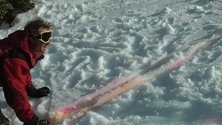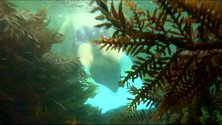Peter Ireland – 8 January, 2013
There is such a halo of earnestness around art-making generally that anything overtly joyful tends to be written off as frivolous. Burrell's work seriously extends the notion of what paint can do as well as athletically parodying sports' seriousness, and perhaps science's too.
Whanganui
Glenn Burrell’s Tylee Residency exhibition
Operation FizZ!
27 October 2012 - 24 February 2013
Not so long ago artists were catergorised as sculptors, painters, or printmakers. The advent of conceptual art in the 1970s put the cat among the pigeons, and suddenly video and performance artists as well as film-makers were cooing in the aviary. Things have even got worse under postmodernism: now there are ceramic artists and even photographers queuing for their share of the grit. Glenn Burrell’s practice brings more bad news. His work blows away all the categories of artistic practice depended on for centuries to make sense of production and bring joy to the hearts of artwork cataloguers. Does Vernon or KEmu have a box for “guy who does weird stuff with paint”?
Burrell was born in Taranaki in 1981 and attended the art school at the Western Institute of Technology (WITT) in New Plymouth between 1999 and 2003, graduating with a Bachelor of Visual Art. As it does at secondary school, “art” pretty much equated with “painting” so that’s what he went to the WITT to do. They say the number eight wire gate originated in Taranaki, which perhaps suggests a local propensity for imaginative, left-of-centre takes on existing models - the same province threw up Ronald Hugh Morrieson remember - so it wasn’t long before Burrell grew restless with the 2D limitations of painting and, as he said during a Sarjeant talk shortly after taking up the three-month residency in May 2011, wanted something more “off the wall”.
“Off the wall” has pretty much characterised his practice in all senses for the last dozen years and why Operation FizZ! is subtitled not “painting exhibition” but painting expedition, where the intelligence of Marcel Duchamp meets the endurance of Ernest Shackleton.
Burrell’s original impulse seems to have been along the lines of OK, the substance of paint’s usually expected to lie quietly on canvas etc, but hey, let’s have a look at what else it can do, and how far can it be stretched to its physical limits. So, he began with some familiar domestic objects: a kitchen bench, a typewriter, a desk top, a lawnmower and a wheelchair and painted them. No, painted them. Several coats in fact, usually in a pastelish acrylic monochrome, then, using a scalpel with a precision a neurosurgeon would envy, he surgically removed the layered paint from the object, painstakingly sealing the joins with paint and then simply - the easy bit - he placed the cast-off skin on the floor to be viewed in all its pathetic glory.
All this sounds relatively easy when you think just of the larger components such as the bench and desk tops, but when you get down to items such as paperclips on the desk, dozens of wheel spokes and ants on the kitchen bench it’s not easy to avoid using the word obsessional. But, of course, it’s too easy for the viewer to become trapped in admiration for the skill and patience involved. A couple of years ago Robert Heald informed visitors to a John Ward Knox painting show that the work represented something like 600 hours’ work, and the question had to be asked that had it represented 1200 hours would it be twice as good? Taking Burrell’s effort on board is nothing more than noticing that the bus to the Railway Station is going along Lambton Quay.
The fascination these paint-skin suits exerts is of another order altogether. They speak soberly of failure, obsolescence, waste, mortality and futility. The objects trick you to come in closer because of their technical facility, then once you’re within range kick you in the guts with their import. There are echoes of Beuys certainly, but the most telling reference in art history could be the section of the Sistine Chapel’s Last Judgement where one figure among the elect holds up the limp, decayed but still recognisable skin of Michelangelo.
All references to Michelangelo must end there because Burrell’s a skinny guy with a terrific amount of energy. A transitional work, a bicycle in pale blue (Burrell has forged an arrangement with Resene’s returned paint scheme), connects with something else he does, with equal focus, and which pointed the way to the next major phase in his art making/paint testing. He’s a keen cyclist and seasoned mountain-biker. In combining his sport with his art he not only extended his testing the limits of paint but he began testing himself physically too.
This began, innocently enough, with “skinning” a medium-sized circular trampoline about three metres in diameter. It was the first time he’d attempted such a large area of paint, and of course, after several coats the sheer weight was significant. So, how do you peel that off without fracture? After doing it he was feeling a bit fractured himself. This became the point of entry for the endurance component of a whole new body of work where the question of how long the paint would last fell into sync with how long he would last.
It began with flippers. The same approach: enough layers to hold the object together but not so many as to limit flexibility. Along the way he discovered that different colours - and even different batches - performed differently. What began as an art project began taking on scientific aspects as well as athletic ones. In testing the flippers among the rocks near Island Bay Burrell, almost by accident (honoured scientific milestones), he began collecting the underwater stones bearing traces of the paint, thus beginning a further documentary phase to these seemingly hair-brained “experiments”. At this point too, his faithful partner Hannah began consistently filming and photographing these performances, work that has given them added life.
Gumboots followed. Each pair was worn to exhaustion along metal roads; the distance measured, the journey filmed and the remains photographed. Given this mix of feet and movement, wedded to the artist’s geographic origins, the next challenge was obvious: skiing Mt Taranaki. The length of skis, the added speed factor, the effect of the cold on the paint and, just how to keep the darned things on were all fresh challenges as he worked away in his Wilton studio in the Capital. One of the more amusing aspects of this project is that during the cold winter of 2011 it snowed in Wellington and Burrell was able to take his skiis for a test run in his own backyard! He used to be an atheist.
Eventually Mts Taranaki and Ruapehu were conquered; more a triumph of hope and playfulness than perhaps of sporting technology, but the video footage is absolutely unforgettable. The fate of the paint-made ski poles, for instance, was decided in milliseconds. That was never in doubt of course, but Burrell has a commitment to completeness, and there’s a gung-ho aspect to his approach that suggests well, you never know.
There were, meanwhile, some experiments with skateboard wheels which is where the potential of skidding was first realised. The angled stress on the layers of paint revealed their colourful geology, and what, for instance, Rohan Wealleans has done with a Stanley knife, Burrell’s done with speed. But not only was the paint shaped, the pavements and roads were inscribed too, in the manner of a funfair Cy Twombly with what the artist himself has called “psychedelic scars” on the landscape.
At this point he returned to his bike. The earlier paint skin version was clearly going nowhere and in any case the inter-active aspect of his new work had become a major focus. He began constructing four cycle components: the tyres, the rear cluster (the set of related cogs for the chain), the brake pads and the handlebar grips. Once enough sets were made he and Team Hannah went to the relatively isolated coastal road to Cape Palliser in the southern Wairarapa and mounted the tests/performances. Some paint performed better than others. A pale yellow tyre was hopeless - it kept curling off. The rear cluster held up beyond expectations and the brake pads were brilliant. The skidmarks were awesome. The videos record beyond question they were having a lot of fun.
There is such a halo of earnestness around art-making generally that anything overtly joyful tends to be written off as frivolous. Burrell’s work seriously extends the notion of what paint can do as well as athletically parodying sports’ seriousness, and perhaps science’s too. His projects extend - and refresh - conceptions of performance art, his goofy antics in the tradition of the court jester posing larger questions that established orders have comfortably forgotten to ask. A committed artist with virtually nothing to sell, his inability to strategise vis a vis the art world is more than outweighed by his seemingly reckless eagerness to take a punt.
Speaking of which, his most recently-realised project was entitled HMS Burrell Dreamboat. Ever since his early flippers project he’s felt the call of the sea, and the call of an inflatable made of paint proved irresistible. His most ambitious project to date, this IRB surf lifesaving boat replica involved a scale and complexity not attempted before. Imagine the trampoline pumped up. Just moving the thing around before the launch would’ve been like Te Papa staff moving their giant squid in a supermarket trolley. The Dreamboat sustained some damage getting into the water and consequently its performance was at the minimum end of the scale. It took on a lot of water and, in the end, had to be laboriously salvaged. Characteristically, Burrell was still jubilant, and he had reason to be.
Potter Peter Lange a few years ago cheekily built a clinker dinghy out of bricks. Later on at a seminar or some such he was asked - as perceived “craftspeople” often are - to define the difference between art and craft. He referred to his dinghy. If it floated, he said, it was craft. If it sank it was art. His floated. Burrell’s sank.
Peter Ireland






 Advertising in this column
Advertising in this column Two Rooms presents a program of residencies and projects
Two Rooms presents a program of residencies and projects



This Discussion has 0 comments.
Comment
Participate
Register to Participate.
Sign in
Sign in to an existing account.